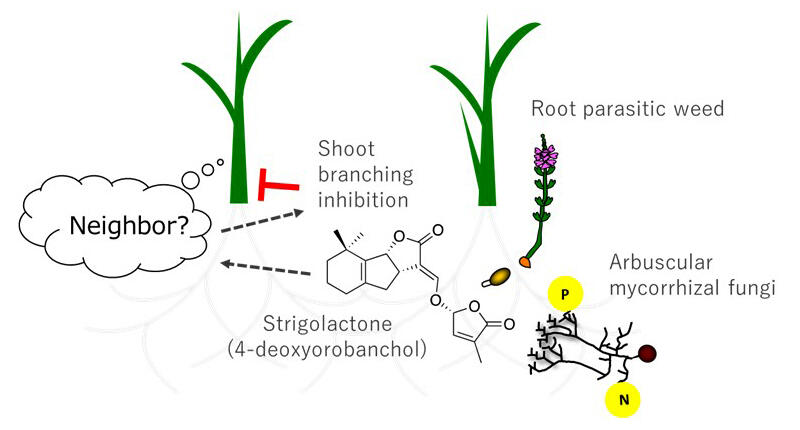A research group has successfully demonstrated that plants may use the secondary metabolite strigolactone, which is exuded from roots, to sense the presence of other nearby plants and control their own growth. The group included Kaori Yoneyama, a Specially Appointed Associate Professor at the Graduate School of Agriculture, Ehime University, with members from Utsunomiya University and the University of Leeds in the UK.

Provided by Ehime University
Strigolactones are plant hormones used by root parasitic weeds and arbuscular mycorrhizal (AM) root fungi to recognize their hosts. They are also used by plants themselves to suppress above-ground growth. The research group noticed that the concentration of strigolactone in a hydroponic culture medium did not change whether the rice plants were cultured with one or three individuals. They also found that the amount of strigolactone secreted per individual decreased as if the rice plants were aware of the others. They then tried doubling the amount of hydroponic culture medium and found that the amount of strigolactones secreted doubled in response, while the concentration of strigolactones in the culture medium remained constant.
The group then tried cultivating strigolactone biosynthetic mutant rice plants, which cannot produce and secrete strigolactones, and wild rice plants. They found that the mutant variety actively absorbed strigolactones (secreted by wild rice) in the culture medium, which were present only at very low concentrations. There was no suppressed growth between the mutant varieties or in individual mutant plants unable to accept strigolactone.
This finding made it clear that rice plants sense the strigolactones present around their roots, determining how much strigolactones they need to make and secrete while also using these amounts to determine their own degree of growth.
Yoneyama commented, "In the future, we would like to uncover how plants sense low concentrations of strigolactones in the rhizosphere and control their own biosynthesis and secretion of strigolactone. Clarifying this mechanism would prove that plants use strigolactones as a tool to estimate future conditions and to understand the presence of neighboring plants."
■ Strigolactones: A collective term for more than 30 types of chemical compounds that have been isolated and identified from root exudates of various plants, mainly using the seed germination activity of root-parasitic weeds as an index. Because strigolactones are chemically unstable and fragile, they are found only in the soil around living roots. They are, therefore, a convenient way for root parasitic weeds and AM root fungi to detect living roots.
This article has been translated by JST with permission from The Science News Ltd.(https://sci-news.co.jp/). Unauthorized reproduction of the article and photographs is prohibited.




